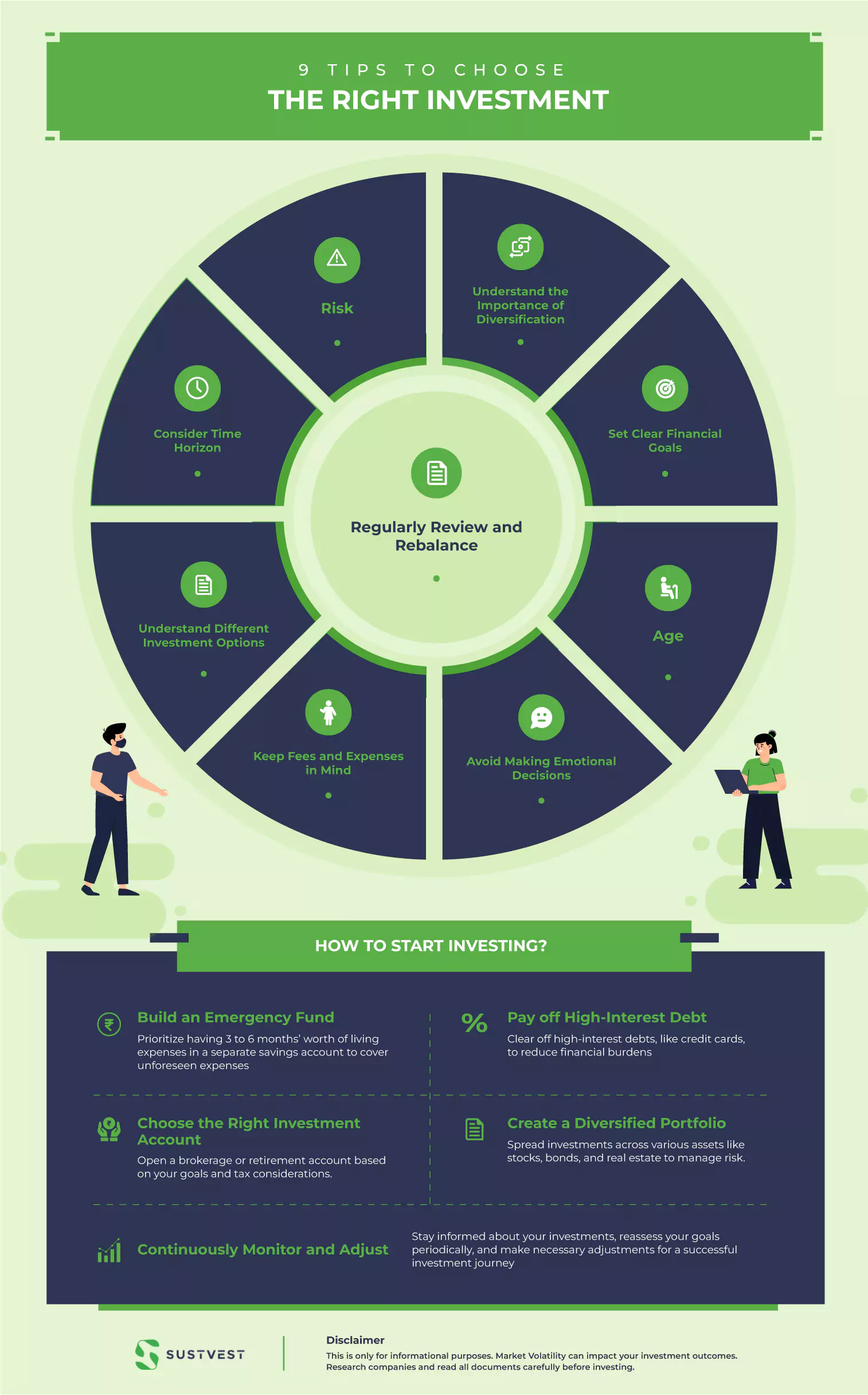Ever felt like a kid in a candy store when looking at investment options? The dazzle, the choices, the overwhelming what-do-I-pick moment? Let’s simplify that for you. Dive into the world of Classification of Investments, the treasure map that reveals where your gold coins should go.
It’s not just about picking random chocolates; it’s about selecting the best flavours that match your taste and satisfy your sweet tooth.
So, ready to pick your candy, or in this case, the right investment?

9 Tips To Choose The Right Investment
The right investment depends on your financial goals, risk tolerance, time horizon, and investment strategy. These tips will help you decide:
1. Risk
Investing always carries some level of risk, even with cash deposits susceptible to inflation. To mitigate risk, diversification is essential. Spreading investments across various companies’ shares prevents total loss if one fails.
Similarly, investing in different asset types with diverse reactions to events balances out movements over time.
While market fluctuations and political events can impact share prices, a diversified portfolio minimises the overall risk exposure, providing a better chance of achieving long-term financial goals.
Remember, reducing risk does not eliminate it entirely, so careful planning and monitoring remain crucial in investment decisions.
2. Understand the Importance of Diversification
Diversification reduces risk by spreading money across diverse investments. You may generate consistent returns by diversifying your portfolio with stocks, bonds, and cash equivalents.
Diversification depends on asset allocation, the proportion of each asset class in your portfolio.
While a balanced 60% stocks and 40% bonds allocation is common, individual preferences and risk tolerance vary. Investors may also explore alternative assets like cryptocurrency, real estate, or private equity to suit their goals and risk appetite.
Also, Diversification and asset allocation are essential concepts in the classification of investments, ensuring a well-rounded and customised approach to portfolio management.
As we underscore the significance of diversification, an increasingly pertinent question arises: Investing in Green Energy for Environmental Conservation – have you considered its potential?
3. Set Clear Financial Goals
Setting clear financial goals is important because it provides a purpose and direction for your investments. Without defined goals, you may make hasty or inconsistent decisions, leading to a lack of focus on your investment strategy.
Knowing what you want to achieve, whether it’s retirement, buying a home, or funding education, help you determine the appropriate risk level, time horizon, and investment vehicles.
Clear goals also serve as a benchmark to track progress and make adjustments if needed. By aligning your investments with specific objectives, you increase the likelihood of achieving your financial aspirations.
4. Consider Time Horizon
Your investment time horizon refers to the length of time you plan to hold an investment before needing the funds.
Longer horizons allow for more aggressive investments with potentially higher returns, as you have more time to recover from market fluctuations.
Shorter horizons call for more conservative choices to safeguard capital. Align your investment decisions with your specific time frame to optimise risk and return.
Longer horizons may favour growth assets like stocks, while shorter horizons may lean towards stable investments like bonds or cash equivalents. Choosing investments that match your time horizon can lead to more effective wealth building.
5. Understand Different Investment Options
Understanding investing options helps you make selections that match your financial goals, risk tolerance, and time horizon.
Each investment kind has unique characteristics, risks, and returns. You can reduce risk and improve portfolio performance by diversifying across asset classes.
- Stocks: Owning shares of a company, representing ownership in the company. Stocks offer the potential for high returns but also come with higher risks.
- Bonds: Debt securities issued by governments or corporations. Bonds provide fixed interest payments and are generally considered safer than stocks but may offer lower returns.
- Real Estate: Investing in properties for rental income or capital appreciation.
- Commodities: Investing in physical goods like gold or agricultural products as a way to diversify and protect against inflation
- Cryptocurrencies: Virtual currencies like Bitcoin, Ethereum, and others are attractive speculative investments.
Remember that your financial status and goals will determine your investment mix. Diversification and understanding of investing possibilities can help you develop a well-balanced portfolio that matches your goals and risk tolerance.
If you’re curious about maximising your returns in the Indian market, don’t miss our guide on How To Make Investments For High Returns And Monthly Income In India: 8 Lucrative Investment Options.
6. Age
Age is a critical factor in investing, and being young provides distinct advantages. With more disposable income and fewer responsibilities, young investors can take higher risks and have the luxury of waiting for longer-term investments to mature.
As one grows older, factors like increased responsibilities and retirement planning come into play, necessitating a shift in investment strategies.
Time becomes a crucial constraint, making it essential to choose investment instruments wisely at different life stages.
Young investors may focus on high-growth assets like stocks, while older investors might prioritise stable income-generating options such as bonds or dividend-paying stocks to align with their changing financial goals.
7. Keep Fees and Expenses in Mind
When selecting investments, it’s crucial to consider the impact of fees and expenses on your overall returns. Even seemingly small costs can accumulate over time and significantly erode your investment gains.
Common fees include brokerage commissions, mutual fund expense ratios, advisory fees, and transaction costs.
To maximise your investment potential, opt for investments with lower expenses. ETFs and index funds often have lower expense ratios compared to actively managed funds.
Additionally, be mindful of hidden fees and read the fine print to understand the full cost of each investment. Minimising fees can lead to improved long-term performance and help you achieve your financial goals more efficiently.
8. Avoid Making Emotional Decisions
Emotions can be detrimental to investment success. It causes investors to make impulsive decisions based on short-term market fluctuations or fear.
Rational decision-making is essential when investing, as emotional reactions can lead to buying at market peaks and selling at lows, resulting in losses.
To avoid emotional decision-making, investors should stick to a well-thought-out investment plan that aligns with their financial goals and risk tolerance.
Regularly reviewing the portfolio’s performance and making adjustments based on sound analysis, rather than reacting to emotions, helps maintain a disciplined approach to investing.
By staying disciplined and adhering to a well-thought-out investment plan, investors can avoid reactionary behaviours and stay focused on their chosen investment categories.
9. Regularly Review and Rebalance
Regularly review and rebalance your investment portfolio to align with your financial goals and risk tolerance, considering the dynamic nature of financial markets.
The periodic assessment ensures that your portfolio remains diversified and in line with your chosen investment strategy. Rebalancing involves adjusting the allocation of assets based on their performance and market conditions.
Market fluctuations may cause certain assets to outperform or underperform, altering the original asset allocation.
By rebalancing, you can manage risks effectively and capitalise on market opportunities. This disciplined approach helps you adhere to the principles of financial markets classification.
It also optimises returns while mitigating potential losses and ensuring your investments stay on track to meet your long-term objectives.
How to Start Investing?
Starting to invest can be a rewarding step towards achieving your financial goals. Here are some steps to help you begin your investment journey:
- Build an Emergency Fund: Prioritize having 3 to 6 months’ worth of living expenses in a separate savings account to cover unforeseen expenses.
- Pay off High-Interest Debt: Clear off high-interest debts, like credit cards, to reduce financial burdens.
- Choose the Right Investment Account: Open a brokerage or retirement account based on your goals and tax considerations.
- Create a Diversified Portfolio: Spread investments across various assets like stocks, bonds, and real estate to manage risk.
- Continuously Monitor and Adjust: Stay informed about your investments, reassess your goals periodically, and make necessary adjustments for a successful investment journey.
Remember, the key to successful investing lies in patience, discipline, and staying committed to your long-term goals.

FAQs On Classification Of Investments
What is the significance of the Classification of investments?
Investment classification helps categorise assets based on risk and return profiles, aiding in diversifying your portfolio effectively.
Can I start investing with a small budget?
Absolutely! Many investment options cater to small budgets, like fractional shares and mutual funds, allowing gradual growth.
Should I solely focus on high-return investments?
Not necessarily. Balancing high-return and low-risk investments helps manage overall portfolio risk and long-term stability.
Is seeking professional advice essential for choosing investments?
While not mandatory, consulting a financial advisor can provide valuable insights and personalised strategies for optimal results.
Conclusion
Selecting the ideal investment for your needs requires careful consideration and understanding of your financial goals, risk tolerance, and time horizon.
By evaluating different investment classifications and their potential returns, you can make informed decisions that align with your objectives.
Remember to diversify your portfolio and seek professional advice if necessary.
Entering a new phase of life? Check out our insights on How to Grow Your Wealth in Your 30s? to further amplify your financial journey.
Make your money work for you with SustVest, a sustainable investment platform designed to cater to your specific needs while promoting environmental and social responsibility.

Founder of Sustvest
Hardik completed his B.Tech from BITS Pilani. Keeping the current global scenario, the growth of renewable energy in mind, and people looking for investment opportunities in mind he founded SustVest ( formerly, Solar Grid X ) in 2018. This venture led him to achieve the ‘Emerging Fintech Talent of the Year in MENA region ‘ in October 2019.




